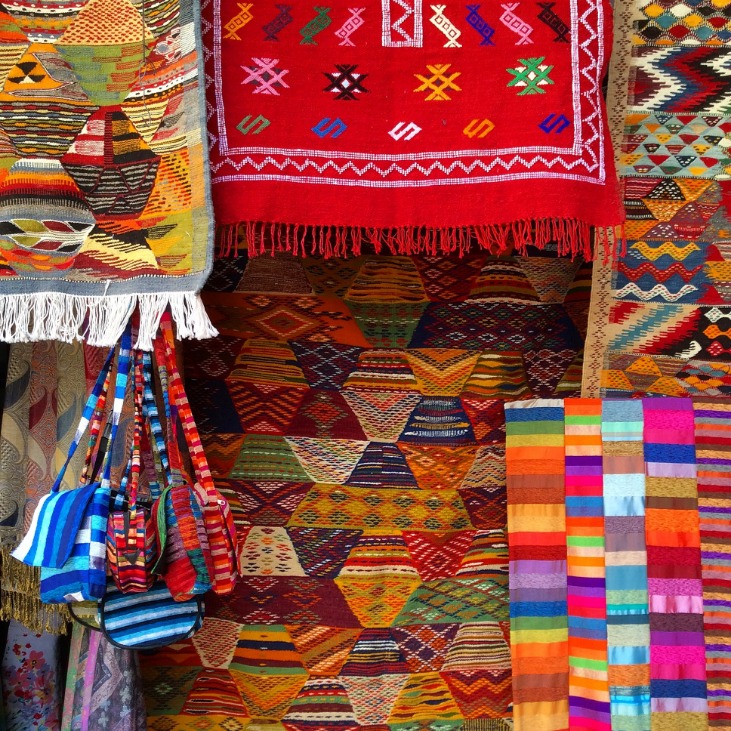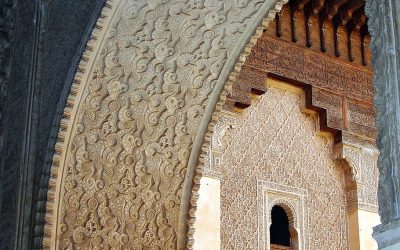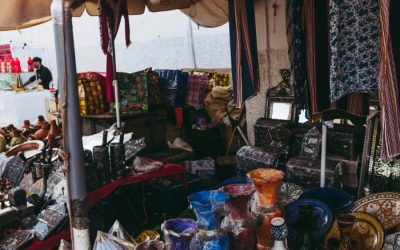Geography and Landscape of Morocco
Morocco is a country rich in diverse geography and stunning landscapes that offer a captivating experience for explorers. From the rugged peaks of the Atlas Mountains to the vast Sahara Desert, the country’s terrain showcases a remarkable variety of natural features. Its coastline along the Atlantic Ocean and Mediterranean Sea further adds to its scenic beauty, creating a unique blend of mountains, deserts, and coastal landscapes that make Morocco a fascinating destination to explore.
Mountain Ranges: The Atlas and Rif Mountains
Explore Morocco and discover its diverse geography and stunning landscapes, prominently featuring the majestic mountain ranges. The Atlas Mountains stretch across the central and southern parts of the country, forming a vital geographical barrier that influences climate and biodiversity. These mountains are characterized by rugged peaks, deep valleys, and lush green terraces, making them a popular destination for trekking and adventure tourism. The highest peak in North Africa, Mount Toubkal, is located in the Atlas range, standing at 4,167 meters above sea level.
In addition to the Atlas, the Rif Mountains run along the northern coast of Morocco, parallel to the Mediterranean Sea. The Rif range is known for its dramatic terrain, steep slopes, and vibrant green landscapes, which contrast with the arid plains of the surrounding regions. This mountain range is home to numerous Berber communities and offers rich cultural experiences for visitors. The combination of the Atlas and Rif Mountains makes Morocco a country characterized by striking mountainous landscapes that shape its climate, agriculture, and cultural diversity.
Desert Landscapes: Sahara Desert
Explore Morocco and discover its diverse geography and stunning landscapes, with a particular emphasis on the vast Sahara Desert. The Sahara Desert in Morocco is a remarkable expanse of golden sands and rolling dunes that stretches across the southeastern part of the country. This desert landscape is characterized by towering dunes, some reaching up to 180 meters high, and expansive salt flats, offering a mesmerizing view for adventurers and travelers alike. The Sahara plays a crucial role in shaping Morocco’s climate, creating arid conditions in the desert regions while supporting unique flora and fauna adapted to harsh environments. Visiting the Sahara provides an unforgettable experience of camel trekking, exploring ancient kasbahs, and observing breathtaking sunsets over endless sands, making it a key highlight for those exploring Morocco’s remarkable geography and landscapes.
Coastal Regions and Beaches
Explore Morocco’s diverse geography and stunning landscapes, which encompass rugged mountains, expansive deserts, fertile plains, and extensive coastlines. The country is situated in North Africa, bordered by the Atlantic Ocean and the Mediterranean Sea, offering a variety of coastal environments. The coastal regions of Morocco are known for their beautiful beaches, vibrant port cities, and lively seaside towns. The Atlantic coast, stretching from the Rif Mountains in the north to the southern border, features long sandy beaches ideal for surfing and beach activities, with popular destinations such as Essaouira and Agadir. The Mediterranean coast, including cities like Tangier and Nador, offers a warmer climate and picturesque coves. These coastal areas are not only scenic but also vital for Morocco’s fishing industry and tourism, attracting visitors from around the world to enjoy the Mediterranean and Atlantic shores of this fascinating country.
Fiord and Oases in the Interior
Explore Morocco’s diverse geography and captivating landscapes that showcase a blend of natural beauty and cultural richness. The country features a range of terrains, from rugged mountain ranges to expansive desert plains, offering a variety of outdoor experiences. Among its most intriguing geographical features are fiords and oases found within the interior regions. Fiords, although not as extensive as those in Scandinavia, are present in some of Morocco’s coastal and mountainous areas, created by glacial activity and providing stunning fjord-like scenery. Meanwhile, oases are vital ecosystems nestled within the arid desert lands, forming lush, fertile havens surrounded by palm trees and date groves. These oases serve as crucial centers for local agriculture and habitation, supporting communities that have thrived in harsh desert environments for centuries. Together, these landscapes highlight Morocco’s remarkable ability to adapt to various climatic conditions, making it a fascinating destination for nature enthusiasts and explorers alike.
Historically Rich Cities and Towns
Morocco is a land steeped in history, where ancient cities and towns tell stories of diverse civilizations that have shaped its cultural landscape. From bustling marketplaces and historic medinas to centuries-old architecture, these historically rich locations offer a glimpse into the country’s vibrant past. Exploring Morocco’s cities and towns provides a unique opportunity to experience the legacy of its imperial heritage and the traditions that continue to thrive today.
Marrakech: The Red City
Explore Morocco and discover the enchanting city of Marrakech, also known as the Red City due to its distinctive ochre-colored walls. This historic city is a vibrant tapestry of culture, history, and architecture that reflects Morocco’s rich heritage. Marrakech has been a significant center for trade, art, and religion for centuries, making it a must-visit destination for travelers seeking an immersive experience into Moroccan traditions.
- Historically significant city founded in the 11th century, Marrakech has maintained its status as a cultural and imperial hub.
- The city’s iconic medina is a UNESCO World Heritage site, bursting with bustling markets, ancient palaces, and mosques.
- Notable landmarks include the Koutoubia Mosque, the Saadian Tombs, and the stunning Bahia Palace.
- Traditional riads, bustling souks, and vibrant plazas like Jemaa el-Fnaa showcase the city’s lively atmosphere.
- Marrakech has a long history of craftsmanship, including textiles, pottery, and jewelry that continue to thrive today.
Fez: The Cultural Hub
Fez, often regarded as the cultural and spiritual heart of Morocco, is a city brimming with historical significance and vibrant traditions. Renowned for its well-preserved medieval architecture, ancient souks, and religious institutions, Fez offers a unique glimpse into Morocco’s rich heritage. The city’s UNESCO World Heritage status highlights its importance as a center of learning and commerce over centuries.
Explore the captivating medina of Fez, one of the largest and oldest in the world, where labyrinthine streets lead to bustling markets and historic sites. The University of al-Qarawiyyin, founded in 859 AD, stands as a symbol of scholarly excellence and is considered one of the oldest continuously operating universities globally. Visitors can also admire the ornate palaces, traditional tanneries, and mosques that reflect the city’s artistic and religious history.
Fez is more than just a city; it is a living museum showcasing Morocco’s cultural tapestry. Walking through its ancient streets offers an immersive experience into the artistry, spirituality, and craftsmanship that have shaped Moroccan identity for centuries. Discovering Fez is essential for anyone eager to explore Morocco’s historical richness and cultural depth.
Córdoba and Rabat: Political and Cultural Capitals
Exploring Morocco reveals a diverse tapestry of historically rich cities and towns, each serving as vital centers of political and cultural heritage. Córdoba, though primarily associated with Spain, is an exemplary historical city that exemplifies the Islamic Golden Age, renowned for its stunning architecture and intellectual prominence. Rabat, the capital of Morocco, stands as a testament to contemporary political significance while also preserving its historical sites that reflect its layered past. These cities exemplify Morocco’s deep-rooted history and its role as a nucleus of cultural and political development in the region.
Chefchaouen: The Blue Pearl
Chefchaouen, renowned as the Blue Pearl of Morocco, is a city steeped in history and culture. Nestled in the Rif Mountains, this charming town is famous for its vibrant blue-painted streets and buildings that create a mesmerizing atmosphere for visitors. The city’s roots date back to 1471, originally established as a fortress to defend against Portuguese invasions and later became a refuge for Jewish and Muslim refugees fleeing from Spain. Its rich history is reflected in the blend of architecture, traditional crafts, and local legends that permeate the city.
Exploring Chefchaouen offers a unique glimpse into Morocco’s diverse heritage. The medina is a maze of narrow alleys, bustling markets, and historic sites, including the Kasbah Museum and the Grand Mosque. The town’s vibrant culture and serene mountain surroundings make it an ideal destination to experience Moroccan life, artisanal craftsmanship, and the spiritual atmosphere of this historically significant city. Visitors can enjoy panoramic views of the Rif Mountains, explore traditional souks, and indulge in local cuisine, all while immersing themselves in a place that has preserved its history through stunning architecture and welcoming communities.
Moroccan Culture and Traditions
Moroccan culture and traditions are a vibrant blend of Arab, Berber, Andalusian, and French influences, creating a rich tapestry of history and customs. From colorful markets and intricate crafts to captivating music and warm hospitality, Morocco offers a unique cultural experience. Exploring Morocco provides a glimpse into its ancient traditions, lively festivals, and the way its people preserve their heritage while embracing modernity.
Traditional Music and Dance
Explore Morocco reveals a rich tapestry of culture and traditions that have been preserved through centuries. Moroccan culture is a vibrant blend of Arab, Berber, African, and Andalusian influences, reflected in its architecture, cuisine, clothing, and social customs. Traditional values emphasize hospitality, family connections, and community, making Moroccan society warm and welcoming to visitors. The country’s cultural diversity is celebrated in various festivals, markets, and artistic expressions that showcase its unique heritage.
Music and dance are integral to Moroccan culture, serving as a means of storytelling and communal celebration. Traditional music includes genres such as Gnawa, which combines spiritual chants and rhythmic instruments, and Andalusian music, characterized by intricate melodies and poetic lyrics. Dance forms like the Derbake drum dance and the energetic Ahidous folk dance often accompany celebrations and religious events. These art forms not only entertain but also preserve Morocco’s historical and cultural narratives, offering a captivating glimpse into the soul of this diverse nation.
Handicrafts and Souks
Exploring Morocco offers a fascinating journey into a vibrant tapestry of culture and traditions that have been preserved for centuries. Moroccan culture is a blend of Arab, Berber, African, and European influences, creating a unique and colorful heritage. The country is renowned for its rich traditions, lively music, exquisite cuisine, and warm hospitality. Visitors can immerse themselves in a world where ancient customs coexist with modern life, making each experience memorable and authentic.
Handicrafts are a vital part of Moroccan culture, showcasing the artistry and craftsmanship passed down through generations. Intricate textiles, beautiful pottery, leather goods, and finely woven rugs are some of the popular products you can find. These handcrafted items are often made using traditional techniques that have remained unchanged for centuries, reflecting the creative spirit and cultural identity of Moroccan communities.
The souks, or bustling markets, are central to Moroccan daily life and offer an immersive shopping experience. Streets are lined with vendors selling everything from spices, herbs, and teas to jewelry, lanterns, and antique furniture. Navigating through the maze-like alleys of Marrakech, Fes, or Chefchaouen provides insight into local customs and an opportunity to engage with friendly merchants eager to share their stories and wares.
- Experience the vibrant atmosphere of Moroccan souks, filled with colorful displays and aromatic spices.
- Discover traditional handicrafts such as pottery, textiles, and leather goods crafted by skilled artisans.
- Explore the diverse cultural influences reflected in Moroccan music, dance, and cuisine.
- Visit historic cities and villages to witness the preservation of ancient customs and traditions.
- Engage with local vendors and learn about the stories behind their handcrafted products.
Cuisine: Tagines, Couscous, and Spices
Explore Morocco, a country rich in culture and traditions that reflect a unique blend of Arab, Berber, and Mediterranean influences. Its vibrant history is evident in its colorful festivals, traditional music, and intricate craftsmanship, offering a captivating glimpse into a heritage that has been preserved for centuries.
Moroccan cuisine is renowned for its flavorful dishes and aromatic spices. Tagines, slow-cooked stews named after the earthenware pot they are prepared in, are a culinary staple. These dishes often combine tender meats like chicken or lamb with vegetables, dried fruits, and a blend of spices such as saffron, cinnamon, and ginger, creating a harmonious mix of sweet and savory flavors.
Couscous is another iconic Moroccan dish, typically served as a staple meal during gatherings or special occasions. Fine-grained semolina wheat is steamed to perfection and topped with a hearty mixture of vegetables, meats, and a flavorful broth. The dish’s versatility and comforting taste make it a beloved part of Moroccan hospitality.
Spices play a vital role in Moroccan cuisine, not only enhancing the flavor but also adding vibrant color and aroma. The use of cumin, paprika, turmeric, and coriander is widespread, reflecting the historical trade routes that brought diverse ingredients to Moroccan kitchens. These spices are often combined in complex blends like ras el hanout, which translates to “head of the shop,” embodying the essence of Moroccan spice mastery.
Festivals and Cultural Events
Explore Morocco offers a rich tapestry of culture and traditions that reflect its diverse history and vibrant communities. Moroccan culture is a blend of Arab, Berber, and French influences, creating a unique and captivating heritage. The country is renowned for its intricate arts, traditional music, and flavorful cuisine that showcase its authentic character.
Festivals and cultural events are an integral part of Moroccan life. The most famous is the Marrakech International Film Festival, attracting filmmakers and artists from around the world. The Feast of Moussem, celebrated by Berber tribes, involves music, dance, and rituals honoring local saints. Ramadan also plays a significant role in Moroccan society, with special prayers, feasts, and communal gatherings during the holy month.
Other notable festivals include the Almond Blossom Festival in Sefrou, where colorful parades and cultural activities highlight the arrival of spring, and the Imilchil Marriage Festival, where Berber tribes come together for traditional singing, dancing, and rituals aimed at uniting couples. These events offer a glimpse into Morocco’s rich cultural heritage and its enduring customs, providing visitors with unforgettable experiences rooted in tradition and community.
Highlights of Moroccan Cuisine
Explore Morocco and discover the vibrant flavors that define its rich culinary heritage. Moroccan cuisine is renowned for its aromatic spices, diverse ingredients, and traditional cooking techniques that create a symphony of taste in every dish. From hearty stews to sweet pastries, the highlights of Moroccan food offer a unique and unforgettable gastronomic experience that reflects the country’s cultural mosaic.
Signature Dishes
Explore Morocco and discover a rich culinary heritage renowned for its vibrant flavors and aromatic spices. Moroccan cuisine is a delightful fusion of Berber, Arab, Andalusian, and French influences, creating a unique gastronomic experience that captivates the senses. From hearty stews to sweet pastries, the dishes reflect Morocco’s diverse cultural tapestry.
One of the most iconic Moroccan dishes is Tagine, a slow-cooked stew prepared in a conical clay pot that enhances the flavors of meat, vegetables, and spices. A signature dish often featuring lamb, chicken, or beef with preserved lemons, olives, and aromatic herbs. Couscous is another staple, typically served with a variety of simmered vegetables and meats, offering a comforting and flavorful meal. Pastilla, a savory pastry filled with pigeon or chicken meat combined with almonds and spices, showcases Moroccan mastery of pastry craftsmanship and balance of sweet and savory elements.
For those with a sweet tooth, Moroccan desserts such as Chebakia, sesame cookies coated in honey, and baklava are popular delights. Mint tea, often infused with fresh mint and served abundantly, is an essential part of Moroccan hospitality. Exploring Moroccan cuisine provides a taste of its vibrant culture and centuries-old culinary traditions that continue to enchant visitors from around the world.
Street Food and Markets
Explore Morocco and discover a vibrant culinary landscape rich in flavors, aromas, and colors. Moroccan cuisine is renowned for its unique blend of spices, fresh ingredients, and traditional cooking methods that create a sensory delight for visitors. From hearty tagines and savory couscous to sweet pastries and fragrant teas, every dish tells a story of cultural heritage and regional diversity.
Street food in Morocco is an essential part of the local experience, offering an authentic taste of everyday life. Markets and street stalls serve up delicious snacks such as msemen (Moroccan pancakes), baghrir (spongy pancakes), and freshly grilled kebabs. Sampling these treats allows travelers to connect with local traditions and enjoy a flavorful, budget-friendly meal in bustling urban settings.
The markets, or souks, are a spectacle of sights, sounds, and smells that beckon visitors to explore. From the vibrant souks of Marrakech and Fes to the coastal markets in Essaouira, each offers a treasure trove of handcrafted goods, spices, herbs, and textiles. Navigating these lively bazaars provides a deeper understanding of Moroccan culture and the craftsmanship passed down through generations.
Tea Culture and Hospitality
Exploring Morocco offers a fascinating journey into a rich cultural tapestry, particularly evident in its vibrant cuisine, tea traditions, and warm hospitality. Moroccan cuisine is renowned for its bold flavors and fragrant spices, with dishes such as tagine, couscous, and pastilla showcasing culinary artistry rooted in history. Tea culture holds a special place in Moroccan life, with the traditional serving of mint tea symbolizing hospitality and friendship, often prepared with a generous amount of fresh mint and time-honored rituals. The Moroccan people are celebrated for their genuine warmth and welcoming nature, making visitors feel at home through their generous hospitality and shared cultural experiences. These elements collectively highlight Morocco’s unique blend of tradition, flavor, and heartfelt hospitality that leaves a lasting impression on all who visit.
Natural and Heritage Attractions
Explore Morocco and discover its rich tapestry of natural beauty and cultural heritage. From breathtaking landscapes to historic landmarks, the country’s natural and heritage attractions offer a unique glimpse into its diverse traditions and stunning environments. Whether wandering through vibrant markets or marveling at ancient ruins, visitors can immerse themselves in the captivating spirit of Morocco.
Ancient Kasbahs and Medina Walls
Exploring Morocco offers a captivating journey through its natural beauty and rich cultural heritage. Natural attractions such as the Sahara Desert, lush valleys, and rugged mountains showcase the country’s diverse landscapes. Heritage sites, including ancient kasbahs and well-preserved medina walls, provide a glimpse into Morocco’s storied history and architectural prowess. These ancient fortresses and city walls stand as testaments to the craftsmanship of past civilizations, offering visitors a sense of stepping back in time while wandering through vibrant markets and historic streets. Discovering these sites allows travelers to experience the deep cultural roots and natural splendors that make Morocco a unique destination.
UNESCO World Heritage Sites
Explore Morocco and discover its rich tapestry of natural and heritage attractions that showcase the country’s diverse landscapes and historical significance. From majestic mountain ranges to vibrant cities, Morocco offers an array of sites that reflect its cultural and natural wealth.
Among the UNESCO World Heritage Sites, Marrakech Medina stands out with its bustling souks, ancient palaces, and vibrant street life, offering a glimpse into Morocco’s historical grandeur. Fes, with its medieval walled city, is renowned for its centuries-old tannery and traditional craftsmanship. The ancient city of Volubilis features well-preserved Roman ruins that highlight Morocco’s importance in ancient history.
Natural attractions are equally captivating. The Sahara Desert offers surreal landscapes of dunes and oases, perfect for adventure and cultural experiences with nomadic tribes. The Atlas Mountains provide breathtaking scenery and opportunities for hiking, skiing, and exploring Berber villages. Additionally, the coastal city of Essaouira boasts scenic beaches and historic fortifications, making it a perfect spot for relaxation and exploration.
National Parks and Wildlife
Explore Morocco to discover a rich tapestry of natural and heritage attractions that showcase its vibrant history and diverse landscapes. From ancient medinas and historic sites to breathtaking national parks, Morocco offers a unique blend of cultural and natural wonders.
Natural attractions in Morocco include stunning landscapes such as the Sahara Desert, the Atlas Mountains, and the expansive beaches along the Atlantic and Mediterranean coasts. These locations provide opportunities for adventure activities like trekking, sandboarding, and relaxing by pristine waters.
Heritage sites are also plentiful, with iconic landmarks like the city of Fes, famed for its medieval Medina and traditional crafts, and Marrakech with its bustling souks and historic palaces. These sites reflect Morocco’s deep roots in history, culture, and architecture.
National parks and wildlife areas such as Ifrane National Park, part of the Middle Atlas, and the Toubkal National Park, home to North Africa’s highest peak, offer visitors chances to observe native flora and fauna. These protected areas are vital for conservation and provide opportunities for eco-tourism and nature exploration.
Activities and Adventures
Discover the diverse and exciting activities and adventures that await in Morocco, a country full of rich culture, stunning landscapes, and vibrant traditions. From exploring the bustling markets of Marrakech to trekking the rugged Atlas Mountains, there is an array of experiences for every traveler. Whether seeking outdoor adventures, cultural immersions, or unforgettable journeys, Morocco offers endless opportunities to create memorable moments.
Desert Trekking and Camel Rides

Discover the thrill of exploring Morocco through its exciting activities and adventures. Embark on a desert trekking journey that takes you across breathtaking dunes, allowing you to experience the vast and stunning landscapes of the Sahara Desert. As you traverse these golden sands, you’ll enjoy a sense of adventure and tranquility, witnessing awe-inspiring sunsets and the serene beauty of the desert environment.
Enjoy traditional camel rides that offer a unique way to explore the desert terrain. Guided by experienced handlers, these rides provide an authentic experience, connecting you with the nomadic lifestyle and rich desert culture. Whether at sunrise or sunset, riding camels across the shifting sands offers a memorable highlight of your Moroccan adventure.
Hiking in the Atlas Mountains
Hiking in the Atlas Mountains offers an unforgettable adventure for outdoor enthusiasts exploring Morocco. The rugged terrain and breathtaking landscapes provide a perfect backdrop for trekking through lush valleys, ancient villages, and snow-capped peaks. Whether you’re a beginner or an experienced hiker, the trails cater to all levels, giving you the opportunity to immerse yourself in the natural beauty and rich culture of the region.
Surfing on Atlantic Coast
Exploring Morocco offers a diverse range of activities and adventures, especially along the picturesque Atlantic Coast where surfing is a major attraction. The region is renowned for its powerful waves and vibrant surf towns, making it a haven for surfers of all levels.
- Enjoy world-class surf breaks in towns like Taghazout, Agadir, and Essaouira, which attract international surfers seeking thrilling rides and perfect barrels.
- Take surf lessons from experienced instructors to improve your skills or simply learn the basics of riding the waves.
- Discover the stunning coastal scenery by exploring hidden beaches and coves only accessible by boat or foot.
- Participate in local surf festivals and competitions that showcase the vibrant surf culture of Morocco.
- Combine surfing with cultural excursions to souks, ancient ruins, and traditional Moroccan cuisine in coastal cities.
Shopping and Bargaining in Souks
Exploring Morocco offers a vibrant array of activities and adventures that immerse visitors in its rich cultural heritage and stunning landscapes. From trekking in the Atlas Mountains and exploring ancient medinas to enjoying desert safaris in the Sahara, there are countless opportunities for memorable experiences. Adventurers can also indulge in water sports along the coastal regions or hike through scenic valleys and fortified cities.
Shopping in Morocco is a captivating experience, especially when wandering through the bustling souks found in cities like Marrakech, Fes, and Casablanca. These markets are filled with colorful stalls offering handcrafted jewelry, pottery, textiles, spices, and leather goods. Engaging in bargaining is a prominent aspect of the souk culture, where haggling with vendors allows visitors to get unique items at affordable prices. This lively exchange not only enhances the shopping experience but also provides insight into local traditions and hospitality.





0 Comments